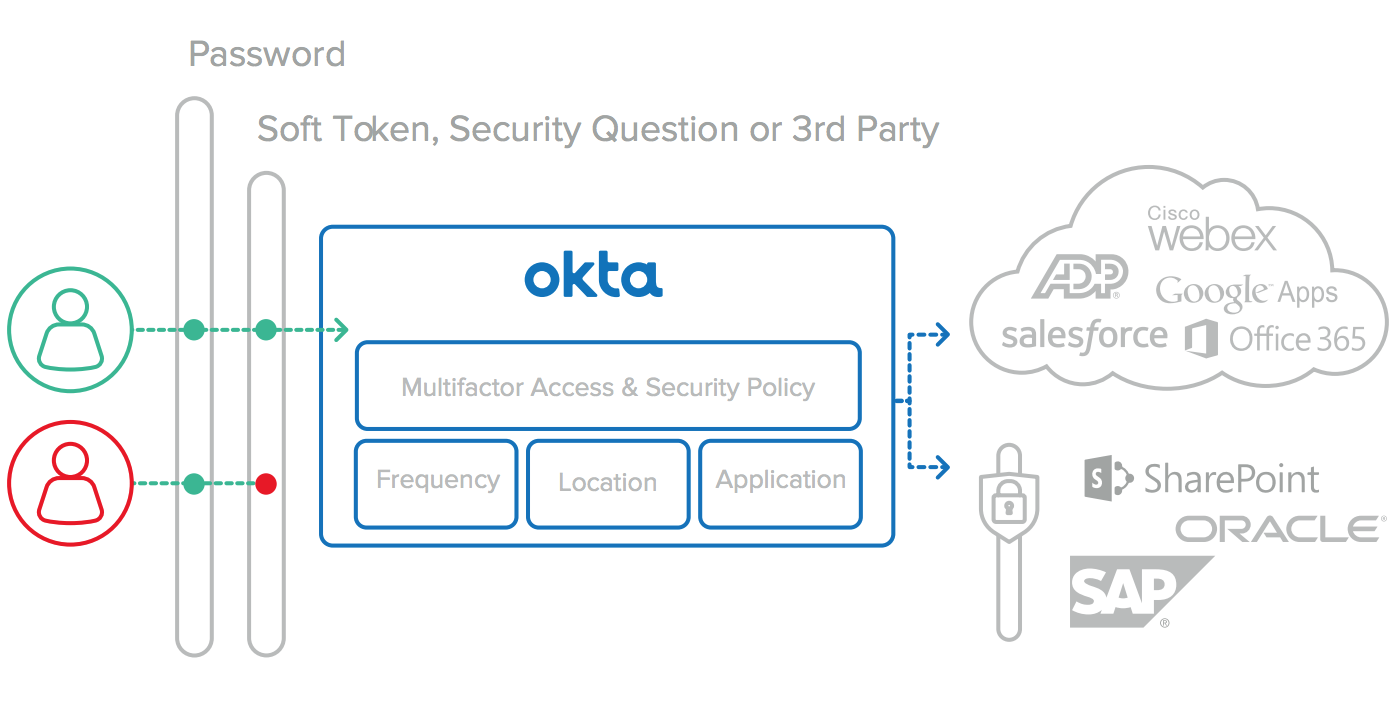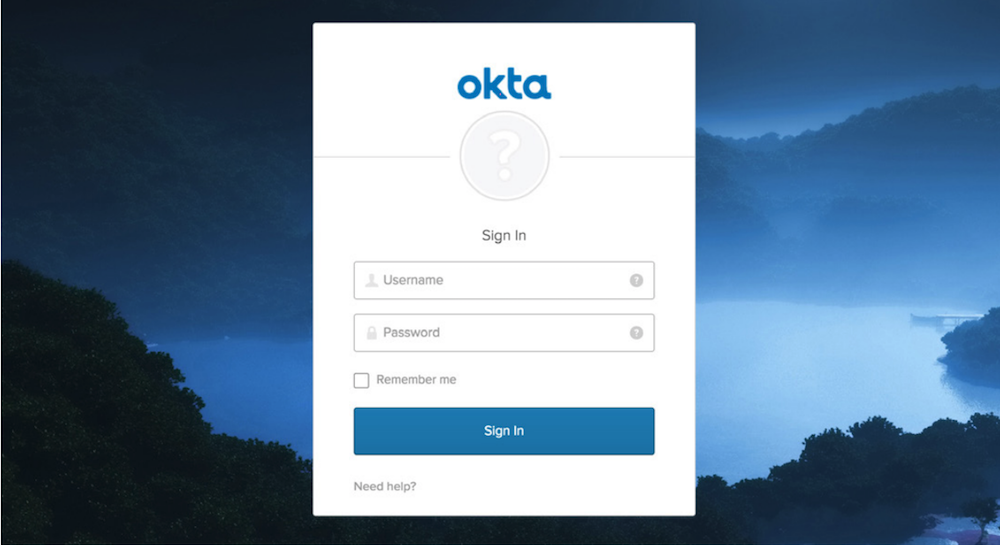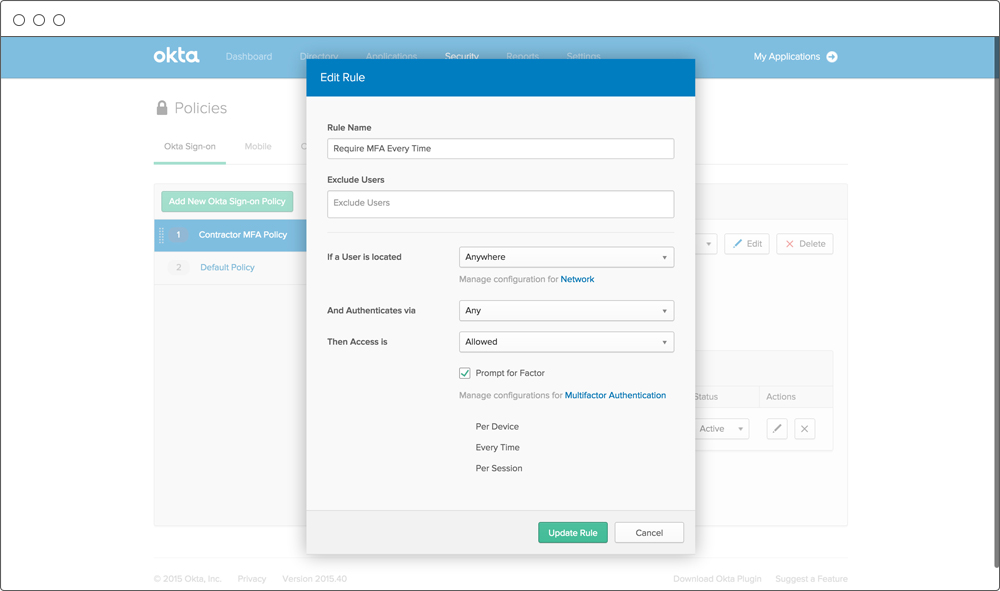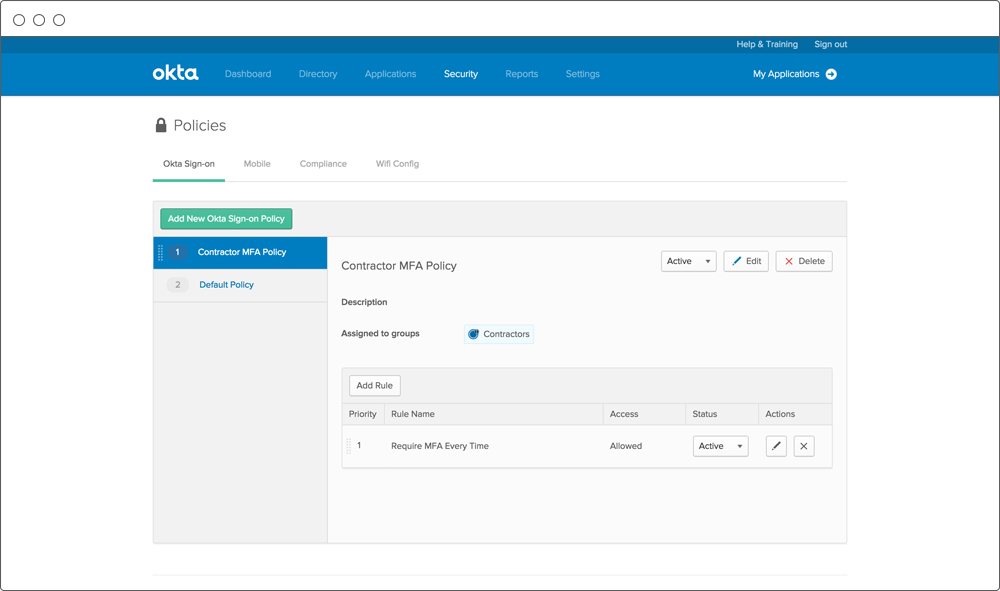Multi-factor Authentication: Moving Beyond User Names & Passwords
As enterprises adopt more cloud applications, addressing this threat will become critical. Unlike older on-premises applications, cloud applications are accessible to anyone on the public Internet. Multi-factor authentication (MFA) is designed to protect against the range of attacks that rely on stealing user credentials.
Read this whitepaper to learn about moving beyond user names and passwords, and how Okta's Multi-factor authentication solution for on premises and cloud apps provides both the highest security and simplest administration possible.
First Steps
The first steps toward embracing the new digital world order does not necessarily have to be disruptive ones. IT leaders are finding new opportunities to reinvent the enterprise with next-gen single sign-on, provisioning and mobility management. IT leaders are finding new opportunities in an era of digital disruption. This executive brief provides a quick overview of how they are driving growth and increasing efficiency by securely connecting the digital enterprise with customers, partners, suppliers and distributors.
Moving Beyond User Names and Passwords
Typical web applications are protected with single-factor authentication: a user name and password. These credentials, in addition to being difficult to manage, leave sensitive data and applications vulnerable to a variety of common attacks. Attackers are using increasingly prevalent and sophisticated techniques to steal passwords to consumer, banking, and enterprise applications. Individual users are vulnerable to password theft via highly targeted spear phishing attacks, while large groups of users can be compromised by an attack on a specific vendor holding their credentials. These credentials are then sold individually or in bulk on the black market to any criminal organisation that might want them.
Examples of recent large-scale password thefts include attacks on Sony and LastPass. In June 2011, the Sony website was broken into and hackers “compromised over 1,000,000 users’ personal information, including passwords, email addresses, home addresses, dates of birth, and all Sony opt-in data associated with their accounts”. In LastPass’s case, the May 2011 breach potentially exposed user names and passwords to a wide swath of web applications.2
The effect of a stolen password is magnified by the fact that users frequently reuse passwords across multiple applications. This means that a stolen Facebook or nytimes.com password may compromise users’ Salesforce.com or Active Directory accounts. A recent study by the Internet security company BitDefender revealed that “75 percent of social networking user name and password samples collected online were identical to those used for email accounts”.3
As enterprises adopt more cloud applications, addressing this threat will become critical. Unlike older on-premises applications, cloud applications are accessible to anyone on the public Internet. And while enterprise cloud software vendors like Salesforce.com and Workday go to considerable measures to ensure they run a highly available and secure service, their login screens are equally as available to attackers as to legitimate users.
Moreover, today’s cloud applications do not easily integrate with existing enterprise products used to monitor dangerous security events, which can make password breaches of enterprise cloud apps difficult if not impossible for most IT organisations to detect.
Enter Multi-factor Authentication
Multi-factor authentication (MFA) is designed to protect against the range of attacks that rely on stealing user credentials. Organisations can use a variety of techniques, but all work by requiring the user to provide something in addition to their primary password— something the user is, has, or knows—before they can be authenticated to the protected service. With MFA in place, even if a user’s password is stolen, his account is safe from unauthorised access.
MFA For On Premises and Cloud Apps
Multi-factor authentication has been in use for decades, most commonly by enterprises adding protection to their VPN gateways and other sensitive resources. This was particularly helpful because VPN gateways provided a single point of entry to on-premises applications that generally just required a user name and password to access.
Today, as key business systems migrate to the public cloud, critical data is as likely to be stored in the cloud as it is behind the firewall and every organisation has a mix of on premises and cloud applications to protect. Most cloud based applications leverage their own siloed identity store and security model to protect this data, making it difficult if not impossible for IT organisation to enforce uniform control policies across all of their applications as they did with MFA on a VPN for on premises apps. Adding MFA one app at a time is simply not practical, as it would require administrators and users to juggle dozens of factor types across as many applications. What organisations need is a unified access gateway that applies equally to VPNs and on-premises and cloudbased applications.
In addition to keeping the back-end of companies running, they will also determine how the front-end connects with customers, partners, suppliers and distributors and the devices associated with them. Indeed, they will determine how information from the front-end feeds into the back-end, and vice versa, transforming traditional companies into dynamic, data-driven enterprises that compete and win at the intersection of the digital and physical worlds.
The Okta Solution
Okta is an enterprise grade identity management service, built from the ground up in the cloud and delivered with an unwavering focus on customer success. The Okta service provides directory services, single sign-on, strong authentication, provisioning, workflow, and built in reporting. Okta’s s secure, flexible ulti-factor authentication comes included as part of the core identity and access management service. Designed to protect against today’s phishing attacks, stolen passwords, and shared credentials, Okta’s MFA solution provides both the highest security and simplest administration possible. Okta’s native multi-factor options can be centrally administered in an integrated fashion, or Okta integrates with existing third-party multi-factor solutions such as Verisign VIP or RSA. Okta also provides options to easily replace or integrate with existing strong authentication solutions, such as RADIUS.
Fully Integrated with the Okta Service

Okta provides multi-factor authentication as a core feature of the Okta identity management service if organisations don’t already have their own solution. Okta builds all MFA functionality with the same focus on flexibility, security, and ease of use that we apply to all other aspects of our product, and it comes bundled with the Okta solution.
Works with your VPN
Okta’s Single Sign-On and MFA solution works with any SAMLenabled SSL VPN, including Juniper SA and Cisco ASA. This enables comprehensive, seamless authentication across all enterprise applications accessed from the public Internet, whether cloudbased, in the DMZ, or protected by a VPN.
Flexible, Secure Verification Options
Organisations can choose from a variety of second factor options, balancing the needs of their user base, the sensitivity of the applications they are protecting, and overall ease of use.
Security Question
Security questions offer added protection by requiring users to provide additional information beyond simple user name and password. This option requires no additional devices and minimal user configuration.

Soft Token
Okta’s soft token is designed for absolute simplicity for the user, and comprehensive security for the Okta administrator. The app can be installed directly from both the Android and Apple App Stores, or directly from Okta for BlackBerry users. It self-configures using the device’s integrated camera. Once installed, users simply read a six-digit number, generated using the industry standard Time-Based One-Time Password algorithm, from their phone screen to access protected resources.
Test Message
For those users who need something stronger than a security question but don’t have a smartphone, Okta’s MFA also offers a text message option which will work with any SMS enabled cell phone. Like the other MFA options it is built into the service, not additional third party services required – it just works.
Centralised Policy Management
One Okta policy controls access to all applications, whether cloudbased or on-premises. Policies can control how often and when to ask users for additional verification. Frequency can range from every login to once per device.

Extra verification can be required for all apps or individual apps, and separate policies can be established for internal and external users.

Easy for Administrators and Users
Okta’s multi-factor authentication solution is easy to use for both administrators and users. As an Okta service, it is fully cloud delivered—no on-premises software or hardware is required. It can be enabled with just two clicks in the Okta administrative interface. Users are fully empowered to self-administer their tokens on their smartphones, subject to the policies administrators define. No clumsy hard tokens or complex SSL certificates are required.
Extensible to Third-Party MFA Solutions
In addition to native Okta MFA support, Okta also integrates with a variety of existing MFA solutions such as Versign VIP and RSA. By leveraging the same extensible architecture that enables Okta to provide a set of pre- integrated applications, customers can also leverage existing MFA products in conjunction with the Okta service.
Conclusion
Okta provides a unified multi-factor authentication solution for your cloud and on premises applications with an architecture designed for both higher levels of security and ease of use for users and administrators. It is an integral part of the core Okta service and comes bundled with every edition of the Okta service. With Okta’s multi-factor authentication, a single policy and token can be used to secure any application managed by the service. It works with cloud-based applications, SSL VPNs, and on-premises web apps. Enabling Okta with MFA protects business-critical data from the most prevalent attacks on the Internet today.